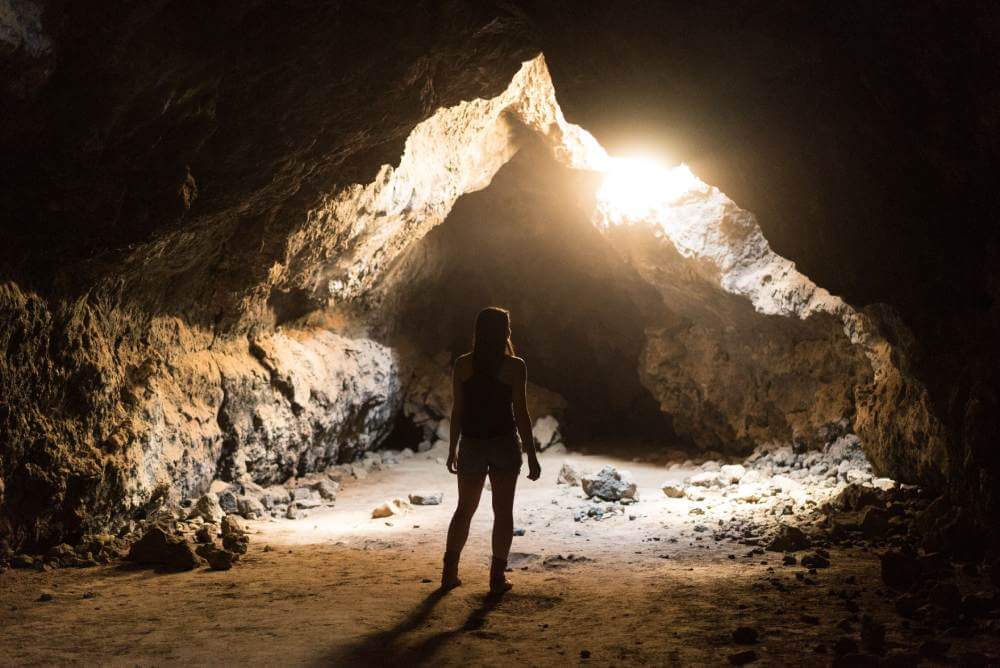The Allegory of the Cave is one of the most famous philosophical allegories presented in Plato’s work “The Republic.” It serves as a powerful metaphor to illustrate the difference between the world of appearances (the physical world perceived through the senses) and the world of forms (the realm of abstract ideas or concepts accessible through reason and intellect).
In the allegory, Plato portrays a group of prisoners who have spent their entire lives chained inside a dark cave, facing a blank wall. They are unable to move their heads and can only see the wall in front of them. Behind the prisoners, there is a fire burning, and between the fire and the prisoners, there is a raised walkway. People outside the cave walk along this walkway, carrying various objects, creating shadows on the wall in front of the prisoners due to the fire’s light.
To the prisoners, these shadows on the wall represent their entire reality. They perceive the shadows as real objects and believe that the shadows are the only truth. Their understanding of the world is limited to what they can observe in the cave, unaware of the true nature of reality outside.
One day, a prisoner is freed from the chains and forced to turn around, facing the walkway and the fire. Initially, the bright light of the fire and the objects carried by the people cause the prisoner pain and discomfort, and he is unable to see the objects themselves clearly. However, as he gradually adapts to the light, he starts to see the actual objects and understands that the shadows on the wall were mere reflections of these objects.
In this process, the prisoner’s perception of reality undergoes a profound transformation. He realizes that the world inside the cave was an illusion and that the true reality lies outside, in the world of forms. The prisoner, having seen the world beyond the cave, feels compelled to share this newfound knowledge with his fellow prisoners.
Returning to the cave to enlighten the others, the freed prisoner encounters disbelief and resistance. His descriptions of the outside world and the world of forms are met with ridicule, as the others cannot comprehend anything beyond the shadows they have known all their lives. The prisoners, conditioned to their confined perspective, reject the idea of an external reality they cannot perceive.
Plato uses this allegory to convey his philosophical views on knowledge, truth, and the nature of reality. The cave represents the material world, the world of appearances, and the shadows symbolize the illusions and falsehoods presented to us by our senses. The world outside the cave represents the realm of forms, the world of true knowledge and eternal ideas, which can only be grasped through reason and intellect.
Applying the Allegory to Attain Happiness
Seek Knowledge and Self-Discovery
To achieve genuine happiness, we must emulate the freed prisoner’s journey and embark on a path of knowledge and self-discovery. The allegory encourages us to question the illusions and appearances that dominate our lives and seek deeper understanding. This involves cultivating intellectual curiosity, critical thinking, and self-reflection to gain insight into our true selves and the world around us.
Embrace Change and Growth
Similar to the freed prisoner’s initial discomfort when exposed to the light outside the cave, embracing change and growth might initially be challenging. However, true happiness lies in the continuous pursuit of personal development and embracing new experiences. Letting go of our comfort zones and exploring different perspectives can lead to a more fulfilling and enriched life.
Challenge Assumptions and Beliefs
The Allegory of the Cave prompts us to challenge our assumptions and beliefs about reality. Often, our preconceived notions and biases restrict our understanding of others and the world. By acknowledging the limitations of our beliefs and engaging in open-minded dialogue, we can foster empathy, compassion, and deeper connections with others, contributing to our overall happiness.
Free Yourself from Material Attachments
Material possessions and societal expectations can create a false sense of happiness, akin to the prisoners’ attachment to the shadows. Detaching ourselves from the pursuit of material wealth and external validation can lead to a sense of liberation and contentment. True happiness is found in cultivating meaningful relationships, pursuing fulfilling passions, and nourishing the soul.
Pursue Intellectual and Philosophical Contemplation
Plato’s allegory emphasizes the value of intellectual pursuits and philosophical contemplation. Engaging in introspective thinking and contemplating the nature of reality and existence can provide a deeper sense of purpose and meaning. Moreover, it opens our minds to the realm of ideas and a greater understanding of the universal truths that shape our lives.
Foster a Community of Shared Understanding
The freed prisoner’s struggle to enlighten his fellow prisoners highlights the importance of creating a supportive community based on shared understanding and knowledge. Surrounding ourselves with individuals who value intellectual growth and self-discovery can cultivate an environment of mutual learning and happiness.
Conclusion
Plato’s Allegory of the Cave offers profound insights into the quest for happiness. By recognizing the limitations of our perceptions and embracing intellectual curiosity, personal growth, and philosophical contemplation, we can break free from the confines of our own “caves.” Embracing change, challenging assumptions, and finding contentment beyond material attachments are key steps to attaining lasting happiness.
Incorporating the wisdom of this allegory into our lives allows us to transcend the shadows of ignorance and emerge into the light of true understanding. By seeking knowledge, fostering compassion, and forming communities of shared understanding, we can navigate the complexities of life with a sense of fulfillment and embrace happiness as an essential component of the human experience.
Check out the Happiness 2.0 Podcast – https://podcast.edwardgdunn.com/




